Unlawful Airstrikes
Human Rights Watch investigated several coalition aerial attacks in Saada City that appeared to be in violation of the laws of war. On the basis of information from relatives, witnesses, medical staff, and local Houthi authorities Human Rights Watch compiled the names and ages of 59 people killed in aerial attacks in Saada City between April 6 and May 11, including 14 women and at least 35 children.[25]
Coalition airstrikes hit at least six residential houses in Saada City. Human Rights Watch found no evidence that the houses were being used for military purposes. In at least two of these attacks, munitions dropped from coalition aircraft struck the houses more than once, suggesting that they were the intended targets. The evidence from other coalition airstrikes, such as those on Houthi security and government buildings in the city, indicates that coalition warplanes were capable of hitting their intended targets with a certain degree of accuracy. VICE News has documented the use of one type of laser-guided air-dropped bomb in an airstrike on Sanaa on May 1 that killed at least 20 people.[26]
Human Rights Watch cannot exclude the possibility that coalition forces intended to hit other targets when they struck the residential houses. For example, in the deadliest of the attacks on residential houses, which destroyed the al-Ibbi house and killed 27 members of the al-Ibbi family, the warplanes possibly targeted an adjacent cultural center, which was also struck.
The attacks on residential houses altogether killed at least 51 people, including 14 women and 32 children. Human Rights Watch conducted separate interviews with nine victims and witnesses of these attacks, all of whom reported that all of those killed and injured in the attacks on residential houses were civilians. Although Human Rights Watch has not been able to independently verify this, the high proportion of women and children from the same families among the victims indicates that the houses’ residents were primarily civilians. The presence of Houthi combatants or other military objectives would not make the attacks lawful if they were carried out indiscriminately or were disproportionate.
Human Rights Watch also found that coalition aircraft attacked and seriously damaged at least five main markets in Saada City. As with the residential houses, multiple strikes on some of the markets suggest that they were the intended targets. Markets are normally civilian objects and should not be attacked. Human Rights Watch saw no evidence indicating that the markets had been used for military purposes, such as for the storage of significant munitions. The presence of small numbers of fighters or weapons in the market would still likely make any bombing of the market a disproportionate attack.
Human Rights Watch also investigated an attack on a school. During a visit to the school, researchers found no evidence to indicate that the school had been used for military purposes, although they were not able to confirm this definitively.
Local Houthi authorities told Human Rights Watch that coalition aircraft had also struck key civilian infrastructure, including the electricity station, a public company that bottles cooking gas, the main public water works, a private wheat storage facility, a company that bottles mineral water, and a petrol station.
Many and perhaps all of these normally civilian objects may have been contributing to the Houthi military effort, making them legitimate military targets. However, the laws of war prohibit attacks that destroy or render useless “objects indispensable to the survival of the civilian population”[27] or would otherwise have a disproportionate impact on civilians compared to the expected military gain from the attack. Not only are food, water, and medicine crucial to the population, but also electricity and petrol.
Even attacks that have a clear military objective and are otherwise lawful should be carried out in a manner that, as much as possible, minimizes civilian harm. The attack on the petrol station, a legitimate target, did not appear to have been carried out in this manner: it occurred in the middle of the day when a long line of people were present, waiting to fill their vehicles. Those killed included at least five civilians, witnesses said.
Human Rights Watch submitted a list of 13 attacks under investigation to Saudi Arabian authorities on May 20, asking what the intended target was for each attack, what weapon or weapons were used, and what precautions the coalition had taken to minimize civilian harm (See Appendix I).[28] At the time of writing, Human Rights Watch had not received any response to its letter.
Human Rights Watch also documented coalition airstrikes on security buildings and installations and government buildings, which were likely legitimate military targets.
Residential Homes<
Al-Sherif House
On the morning of May 10, two bombs struck a residential house and the adjacent street in central Saada City, killing at least five people, including the owner of the house and four neighbors from the Qabas family, the mother and three children. The attack also injured two children from the al-Sherif home.[29]
Ahmed al-Sherif, 38, a watch repairman and the owner of one of the houses that were hit, was still receiving treatment at nearby al-Jumhouri hospital when Human Rights Watch interviewed him five days after the attack. Al-Sherif said that he lost consciousness when the attack happened and that he woke up in the hospital the next day. A metal fragment had cut through his intestines, requiring surgery. The attack also wounded his 7-year-old son Mohammed in the left shoulder and his 12-year-old son Abed in the arm and leg, he said.[30] All three had wounds or bandages consistent with al-Sherif’s description.
Sherif Ahmed, 20, one of al-Sherif’s sons, told Human Rights Watch he was outside the house when the attack struck:
Thankfully my father and two brothers were outside when the first strike hit our house. Luckily my mother and sisters were downstairs, near the back of the house. Five minutes later, a second strike hit the other side of the road. That is how my dad, little sister and brother were wounded.[31]
Human Rights Watch examined the site. Two-thirds of the façade of al-Sherif’s house had been destroyed, leaving the inner rooms exposed. Researchers did not find any munition remnants at the site to indicate the weapon used. A crater about one meter in diameter in the asphalt in front of the house was partially filled with bricks and other debris from the house. There was also significant blast damage to stores on the other side of the street.
Ahmed Al-Sherif died from his injuries on June 3, according to a local Ansar Allah official.[32]
 The remains of al-Sherif’s house, which was hit by an aerial attack on May 10, 2015, killing at least four civilians. © 2015 Ole Solvang/Human Rights Watch
The remains of al-Sherif’s house, which was hit by an aerial attack on May 10, 2015, killing at least four civilians. © 2015 Ole Solvang/Human Rights Watch
Human Rights Watch did not identify any obvious military targets in the vicinity. Sherif Ahmed said that none of his family members were in the Houthi forces and he was not aware of any members in the Qabas family.
Al-Ibbi House
At about 10:50 p.m. on May 5, at least three aerial bombs struck a cultural center and a residential house in southwest Saada City, killing 28 people (27 from one family), including seven women and at least 17 children, and wounding three men.[33]
Local residents told Human Rights Watch that the first bomb struck the Saada Cultural Center and a few minutes later, a second bomb struck the southwest corner of the al-Ibbi family house, which is located next to the center.[34]
Walid al-Ibbi, 35, the only al-Ibbi family member present to survive the attack without injuries, told Human Rights Watch that when the bomb fell on the southwest corner of the house, the family ran outside and towards the eastern entrance at the back of the house, thinking they would be safer in the back apartment. Minutes later, a third strike, possibly with two bombs, hit the part of the house where the family had taken shelter, al-Ibbi said.[35] He told Human Rights Watch:
Just earlier that evening, a family had come to our house to ask for my daughter’s hand in marriage for their son. Now I have lost my wife and all four of my daughters. I cannot believe that everyone I love is gone.[36]
Al-Ibbi said that only three other members of his family survived the attack. His father, Abdullah, a barber, suffered a dislocated jaw and possible brain damage, his doctors in Sanaa told him. A metal fragment struck his brother Younes above one eye, damaging his optical nerve. Doctors told al-Ibbi that Younes may lose his sight if they operate and remove the fragment. Another brother, Ayman, suffered minor injuries. Al-Ibbi said that he was uninjured because he was standing outside the house when the third strike occurred.[37]
Two neighbors gave Human Rights Watch similar accounts of what happened. Saleh Hussein Daglan, 54, who lives next to the al-Ibbi house, said: “I heard the family as they screamed, I ran outside and saw bodies under the rubble. One son, Murad, was screaming ‘Save me! Save me!’ A big stone was crushing his legs. He died.”[38]
Ayed Ayed Kamil, 55, another neighbor three houses down the street from the al-Ibbi house, told Human Rights Watch:
As the last strikes hit, I ran outside and saw four members of the [al-Ibbi] family lying out on the road, under rubble. Three of Abdullah’s sons were dead but one, Younes, was alive. I saw that his forehead was sliced open. The rest of the bodies were in the house including a one-month-old baby and a pregnant woman.[39]
 Ayed Ayed Kamil, a neighbor, sits on the ruins of al-Ibbi house, which was struck in an aerial attack on May 6, 2015. © 2015 Ole Solvang/Human Rights Watch
Ayed Ayed Kamil, a neighbor, sits on the ruins of al-Ibbi house, which was struck in an aerial attack on May 6, 2015. © 2015 Ole Solvang/Human Rights Watch
Kamil told Human Rights Watch that the attack also wounded a man from Yemen’s marginalized muhamasheen community, who later died in the hospital from a fragmentation wound to the back of his neck.[40]
Local residents provided Human Rights Watch with photos of at least 10 children who appeared to be under 10 years of age lying side by side on the floor, apparently lifeless. The residents said the photos were taken right after the strike.
At about 2 a.m. on May 7, another airstrike hit the cultural center next to the al-Ibbi home while local people were still pulling bodies out of the rubble from the earlier strikes, the two neighbors said. This caused the crowd of helpers to immediately disperse. Both men said that they knew of no military targets in the area; they said that the nearest security installation was about two kilometers away.[41]
Human Rights Watch examined satellite images of the airstrikes. Researchers inspected three impact craters on the compound of the cultural center. A crater about one meter in diameter was located at the northern side of the cultural center, right inside the entrance gates. Two bombs appeared to have hit the building itself. The al-Ibbi house had been almost completely reduced to rubble with only part of the back wall and rooms still standing. There was also significant damage to neighboring houses. Human Rights Watch researchers did not find any remnants that could help identify the weapons used in the attacks, but aerial bombs appear to have been used.
Saada Cultural Center and Al-Ibbi House

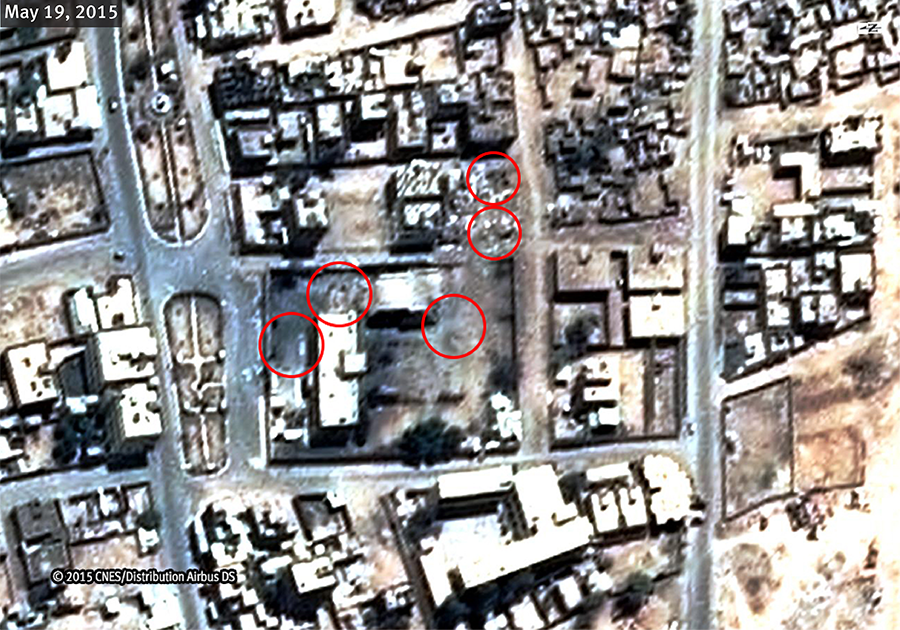 Images of the Saada Cultural Center and the al-Ibbi house
before and after at least five aerial bombs hit both compounds on May 5, 2015,
killing 27 members of the al-Ibbi family, including 17 children.
Images of the Saada Cultural Center and the al-Ibbi house
before and after at least five aerial bombs hit both compounds on May 5, 2015,
killing 27 members of the al-Ibbi family, including 17 children. © CNES 2015/Distribution Airbus DS
The fact that at least three bombs struck the cultural center and that a warplane returned several hours after the main strikes to drop another bomb on the cultural center suggest that the center was the intended target of the attack. Al-Ibbi said that neither his father nor any of his brothers held any role with the Houthis. All of the men in the family, he said, were barbers, working at their family’s two salons in Saada City.
Nabil Ali Jameel, the head of the cultural center, told Human Rights Watch that the center is used for local festivals, theatre pieces, as a library, and to host the local Saada-based Ansar Allah radio station, Massira FM.[42] A radio station used to direct military forces – and not merely report news or make propaganda statements – would be a valid military target, subject to a proportionality analysis. Having listened to some of the radio’s broadcasts, Human Rights Watch did not find evidence that the radio station was being used in that way.
One Saada resident said there were rumors that Houthi forces had used the cultural center as a meeting point, but all others with whom Human Rights Watch spoke did not believe this to be true.[43]
 Rubble from al-Ibbi’s house, which was almost completely destroyed in an airstrike on May 6, 2015 that killed 27 members of the family. © 2015 Ole Solvang/Human Rights Watch
Rubble from al-Ibbi’s house, which was almost completely destroyed in an airstrike on May 6, 2015 that killed 27 members of the family. © 2015 Ole Solvang/Human Rights Watch
Al-Sabra House
In the early hours of April 15, an airstrike hit a residential house in northwest Saada City, killing four people, a woman and her three children, and wounding three to five people, including two children.
Abd al-Razak Qamis, 34, told Human Rights Watch that he heard many airstrikes during the night of April 14/15. One of the strikes hit the home of his neighbor, Ahsen Mohsen al-Sabra, a shopkeeper, and his family of eight. Qamis told Human Rights Watch:
I heard a plane overhead, and then this loud explosion. I looked out of the window, which had shattered with the explosion, and saw Ahsen jumping out of the window of the second floor of the house, clutching his 10-year-old son. I wanted to run outside but was scared that the aircraft might strike us again if we gathered outside.[44]
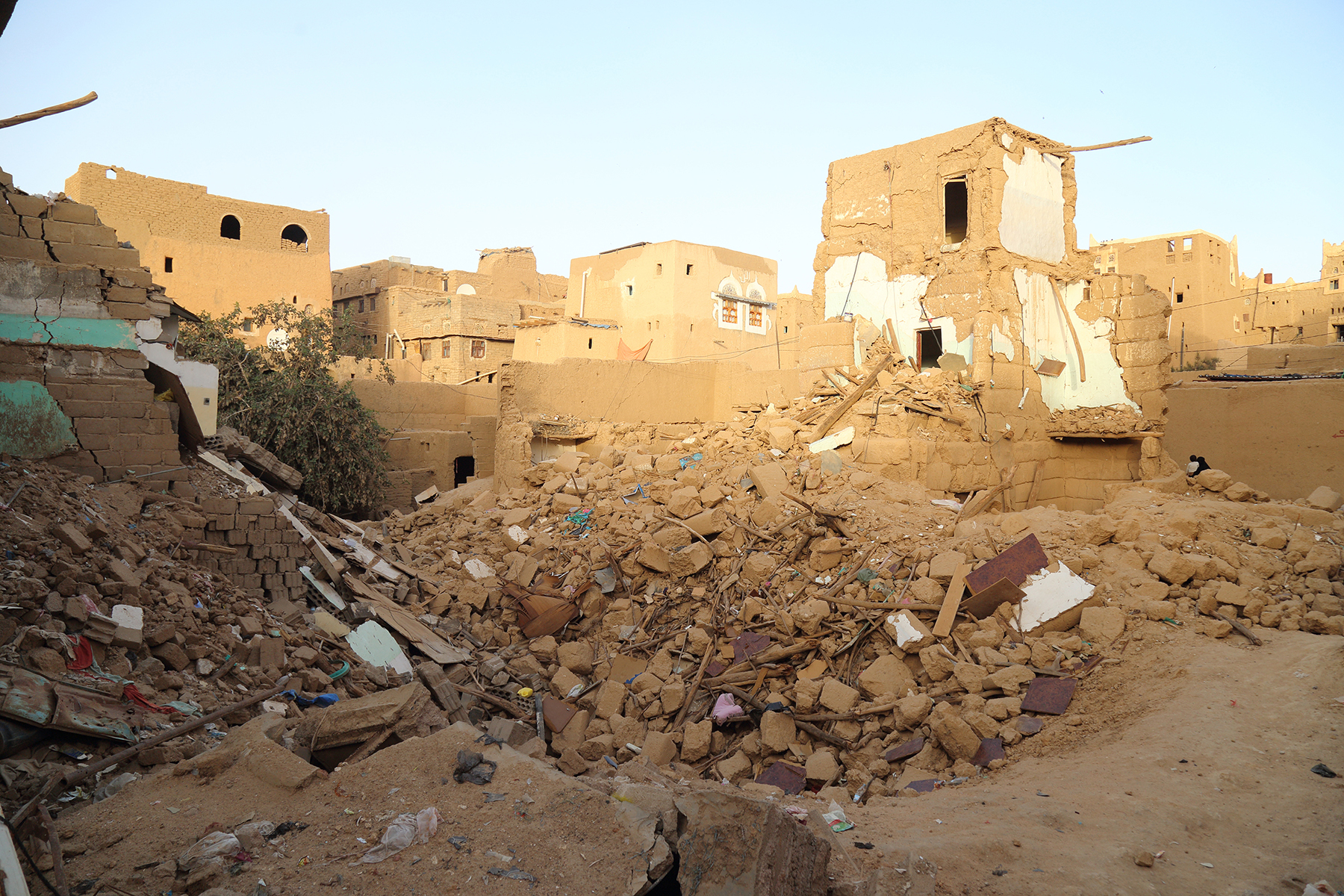 Remnants of al-Sabra’s house, which was struck by an aerial attack on April 15, 2015, which killed a woman and her three children. © 2015 Ole Solvang/Human Rights Watch
Remnants of al-Sabra’s house, which was struck by an aerial attack on April 15, 2015, which killed a woman and her three children. © 2015 Ole Solvang/Human Rights Watch
After 20 minutes, Qamis felt that it was safe enough to run outside to help the family.
Qamis said that the attack killed al-Sabra’s wife and three of his children.[45] A local resident gave Human Rights Watch photos that included one of the destroyed al-Sabra house and several showing three children who appear under the age of 10 lying, apparently lifeless, on the floor. One photo shows what appears to be a covered, larger body lying next to the children.
Al-Jumhouri hospital records show that three people from the al-Sabra family, including two boys, ages 10 and 12, received treatment at the hospital on April 18. Qamis said that the attack also wounded al-Sabra’s pregnant daughter and a woman in a neighboring house. The Ansar Allah list does not contain information about any Houthi casualties from this attack.
Human Rights Watch visited the impact site on May 15. The strike appeared to have destroyed a significant part of the al-Sabra house and caused damage to two adjacent houses. Bricks and other debris from the house partially filled a large crater in front of the house, about three meters in diameter. Human Rights Watch was not able to identify any potential military targets in the vicinity and did not see any remnants to help identify the type of weapon used.
Other Residential Houses
Human Rights Watch investigated aerial attacks on two additional residential houses, but were not able to interview witnesses to these attacks.
On May 5, an aerial attack struck the house of Muhammed al-Hibbi, killing his wife and all seven children when the roof collapsed on top of them, according to his cousin, Nuh Ahmed al-Hibbi.[46] Human Rights Watch did not visit the impact site, but medical staff corroborated the number of casualties.
Around 12:30 a.m. on April 6, an aerial attack struck the home of Muhammad Daghfal, killing seven members of the family, including four women and two children, according to Muhammad Gahsha, a grave worker who buried the dead.[47] Human Rights Watch visited the ruins of the house, which was located in a rural area about five kilometers from the center of Saada City. An investigator at the Salam hospital confirmed the deaths.[48] Satellite imagery recorded on April 7 shows the complete destruction of the Daghfal house. Satellite imagery shows no other damage in the vicinity.
Daghfal House
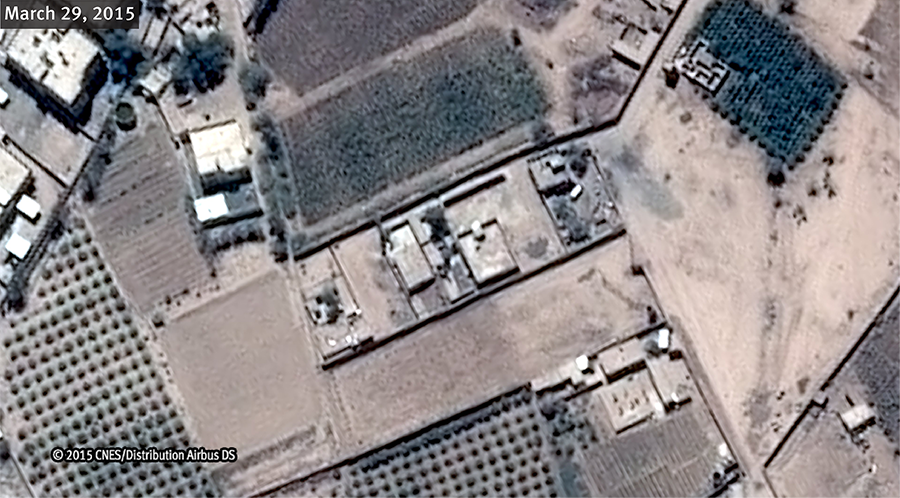
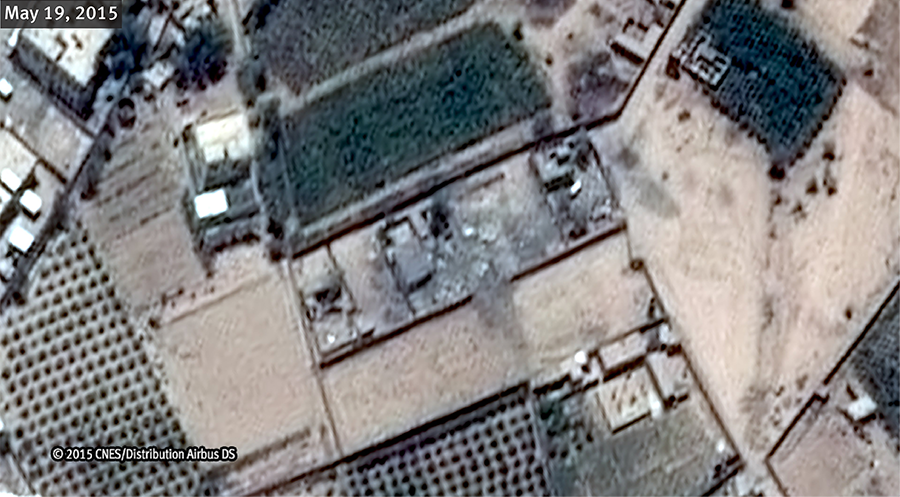 Satellite images of the Daghfal house before and after a
coalition airstrike hit it on April 6, killing seven members of the family,
including four women and two children. © CNES 2015/Distribution Airbus DS
Satellite images of the Daghfal house before and after a
coalition airstrike hit it on April 6, killing seven members of the family,
including four women and two children. © CNES 2015/Distribution Airbus DS
 Ruins of the Daghfal house, which was struck by an aerial attack on April 6, 2015, which killed seven members of the family. © 2015 Ole Solvang/Human Rights Watch
Ruins of the Daghfal house, which was struck by an aerial attack on April 6, 2015, which killed seven members of the family. © 2015 Ole Solvang/Human Rights Watch
Human Rights Watch also investigated the ruins of a residential house near the old market. An Ansar Allah official told Human Rights Watch that warplanes had struck the house on May 7, killing one civilian and wounding two others, but Human Rights Watch was not able to corroborate the number of casualties. Satellite imagery shows that the house was destroyed in the period between May 4 and 10.
Markets
Coalition warplanes attacked and destroyed at least five markets in Saada City, two of them after the coalition announcement that the entire city was a target.[49] Attacks on multiple markets and the absence of evident military objectives in close vicinity to the markets suggest that the markets were the intended targets of the strikes.
Air Strikes on Markets
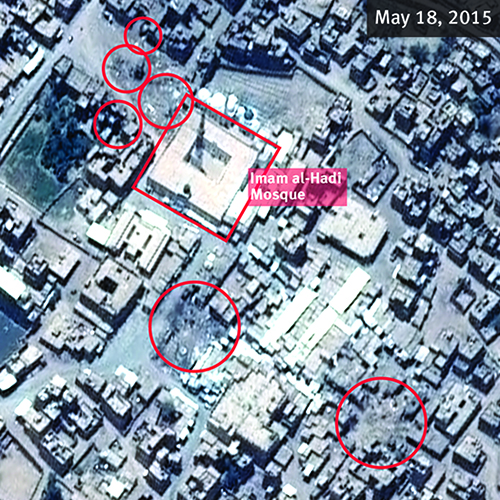 Three markets in the center of Saada city destroyed by
coalition airstrikes in April and May 2015. Top left: market in front of
mosque; middle: small market; bottom right: old market.
© CNES 2015/Distribution Airbus DS
Three markets in the center of Saada city destroyed by
coalition airstrikes in April and May 2015. Top left: market in front of
mosque; middle: small market; bottom right: old market.
© CNES 2015/Distribution Airbus DS
Market Opposite the Imam al-Hadi Mosque
Coalition airstrikes hit the fountain and market outside the Imam al-Hadi mosque’s eastern gate in Saada City. The strike likely took place in the morning on May 9.[50] Local people told Human Rights Watch that the mosque had been closed and unavailable for prayer since March 26, the beginning of the coalition air campaign.
Ali Mahmoud al-Hamoud, 22, a laborer, told Human Rights Watch that he was at the gate of the mosque in the morning when he heard an airplane overhead. Then a bomb hit the fountain in the square in front of the mosque, which is surrounded by a small market with about a dozen shops. He fled but heard several more strikes hit the same area about 15 minutes later.[51]
Talal al-Aizug, 28, a security officer living next door to the mosque, said he was at home with his family when the first strike hit. He told Human Rights Watch that he had heard an airplane flying overhead since 7 a.m. He heard strikes in the far distance earlier, and then a massive explosion as a bomb hit the market in front of his house. Fragments and debris flew through the window of the second floor of his home, into the room he was sitting in, lacerating his head and the side of his chest, and broke through the walls at the corner of the house. He showed Human Rights Watch the injuries he had sustained.[52]
The attack destroyed the fountain and all of the shops, and left a crater about three meters deep and six meters in diameter.
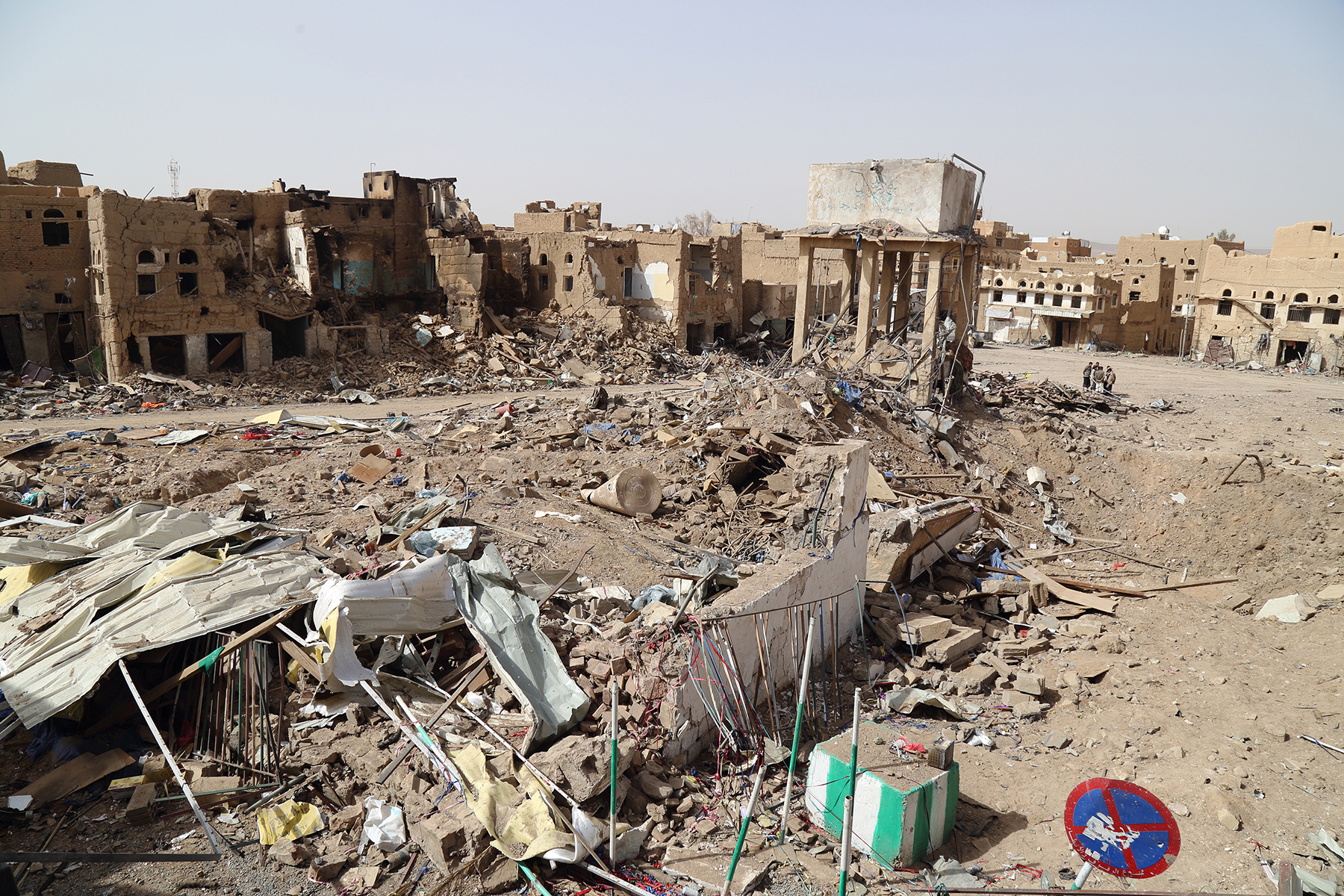 The market in front of the Imam al-Hadi mosque after a May 10, 2015 aerial attack. © 2015 Ole Solvang/Human Rights Watch
The market in front of the Imam al-Hadi mosque after a May 10, 2015 aerial attack. © 2015 Ole Solvang/Human Rights Watch
When Human Rights Watch visited the site researchers observed that the Houthis had posted armed guards at the entrance to the mosque. However, the presence of armed guards would not render the mosque a military target. Dropping multiple bombs on guards near a market appears unlawfully indiscriminate or disproportionate.
Human Rights Watch reviewed satellite imagery recorded on the morning of May 10 and identified four probable impact locations from separate air-dropped munitions on this market and immediately adjacent buildings on either side of the market. Human Rights Watch found no evidence of any military objective in the immediate area.
Old Market
Ali al-Hashhoush, a shopkeeper in the Old Market located in the center of Saada City, told Human Rights Watch that he was at home, a short walk from his shop, when he heard two loud explosions around midnight. About 10 minutes later he heard a third explosion, and about 10 minutes after that, a fourth. After the fourth, he heard a plane overhead. He said:
I ran towards the noise, and saw the market in ruins. I saw one man with a piece of metal in his neck, his leg was almost cut off from the explosion and half of his left hand had been sliced off. I ran past him to the second man. He was an older man that I knew well, very poor, who used to sleep in the market. I picked him up so he could be driven to the hospital – blood was pouring out of his head, down his chest. He died hours later. I saw a third man, but I am not sure what happened to him. Others carried him out of the rubble and he was also wounded.[53]
The strike likely occurred on May 10.[54]
 A shop owner digs through the rubble after an aerial attack struck the Old Market in Saada City on May 10, 2015. © 2015 Ole Solvang/Human Rights Watch
A shop owner digs through the rubble after an aerial attack struck the Old Market in Saada City on May 10, 2015. © 2015 Ole Solvang/Human Rights Watch
Human Rights Watch reviewed satellite imagery recorded in the morning of May 19 and identified a large zone of complete destruction, approximately 30 by 40 meters in size, within the Old Market resulting from impact of one and possibly more air-dropped munitions. Human Rights Watch found no evidence of any military objective in the immediate area.
Human Rights Watch also visited the ruins of a small outdoor market outside Jarman Commercial Market that coalition aircraft attacked on the night of April 15, according to local people, but was unable to interview witnesses to the strike. Satellite imagery shows that the strike took place between the mornings of April 14 and 15.
Human Rights Watch also visited the ruins of the central market located next to the Religious Endowments Ministry. Satellite imagery shows that two attacks struck the market in the period April 7-14, one attack struck on April 14-15, and at least one attack struck in the period May 4-10. According to two men who had shops there, one of the strikes, probably the one on April 14-15, killed a shopkeeper.[55]
The two shopkeepers said another strike hit the building of the Religious Endowments Ministry, which also housed a restaurant, juice shop, and small grocery store, on the night between May 9 and 10. No one was wounded in the strike because it happened at night, they said.[56]
 Two owners dig through the rubble of their shops near the Religious Endowments Ministry that were destroyed by an aerial attack on May 9 or 10, 2015. © 2015 Ole Solvang/Human Rights Watch
Two owners dig through the rubble of their shops near the Religious Endowments Ministry that were destroyed by an aerial attack on May 9 or 10, 2015. © 2015 Ole Solvang/Human Rights Watch
Satellite imagery also shows the destruction of the Othman Mujali Market in the southern part of Saada City. The main market building was destroyed between April 15 and May 2. At least eight aerial bombs were dropped on the remaining market buildings and the adjacent financial building. According to Al-Jumhouri hospital records, the strikes killed two civilians and wounded nine.
Ansar Allah officials told Human Rights Watch that airstrikes had damaged three other markets on the outskirts of the city, the agricultural products market, al-Khafji Market, and Talh market.
Othman Mujali Market

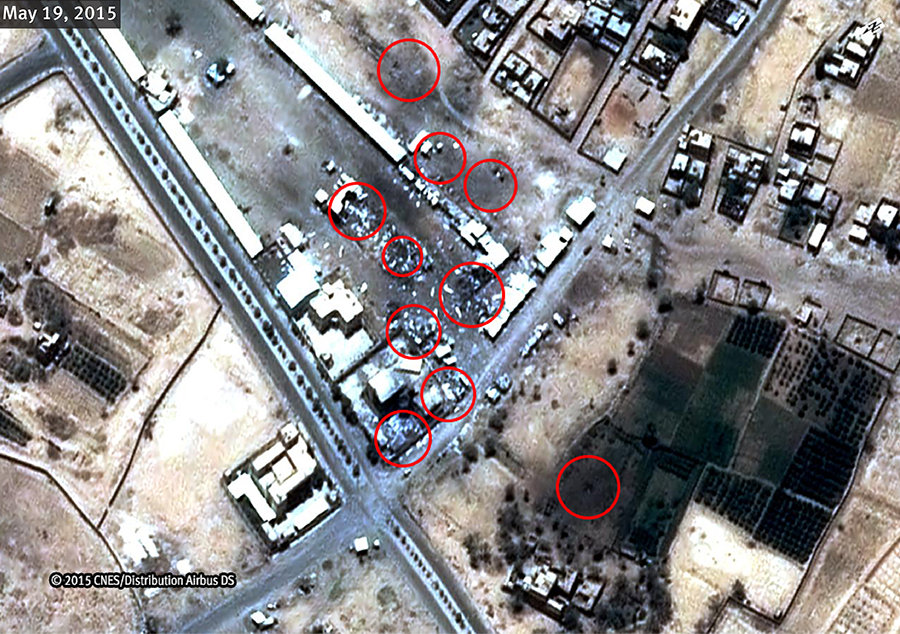 Imagery of the Othman Mujali Market before and after it was
struck by coalition airstrikes between April 15 and May 2, 2015. © CNES
2015/Distribution Airbus DS
Imagery of the Othman Mujali Market before and after it was
struck by coalition airstrikes between April 15 and May 2, 2015. © CNES
2015/Distribution Airbus DS
Al-Munadil Hussein Fayed School
A coalition airstrike hit al-Munadil Hussein Fayed School, a girls’ secondary school in Saada City at 8:30 a.m. on May 11. Abdulhaliq al-Mutamayiz, 32, who lives 100 meters away, told Human Rights Watch that he was walking past the school when one corner of it sustained an aerial strike, leading him and another man to run for cover behind a nearby wall. From there, al-Mutamayiz said he heard another strike three minutes later that hit an open area about 200 meters away, followed by a third strike further away three minutes after that. He said he did not know whether there were any military installations or Houthi fighters at the school. Human Rights Watch’s investigations did not find any evidence that fighters had been using the school.
 A damaged classroom in the al-Munadil Hussein Fayed School, which was struck by an aerial attack on May 11, 2015. © 2015 Ole Solvang/Human Rights Watch
A damaged classroom in the al-Munadil Hussein Fayed School, which was struck by an aerial attack on May 11, 2015. © 2015 Ole Solvang/Human Rights Watch
All education in Yemen has been suspended since March 26, when the coalition air campaign began, and no one was present at the school at the time of the strike, local residents told Human Rights Watch.
A neighboring landowner, Muhammad Ali Saleh, showed Human Rights Watch a deep crater around one meter in diameter in the middle of his field, which he said was made by an aerial munition that burrowed deep into the ground when the school was hit in the strike. Saleh said that the munition was still buried in the ground.
Jarman Petrol Station
On April 15, at least one aerial bomb struck the Jarman petrol station in western Saada City, killing at least five people and injuring 23 – though likely many more -- who were waiting in line to fill their cars with gasoline.
Abed Abd al-Rahman Ali, 23, a car mechanic, told Human Rights Watch that about 50 cars were lined up outside the petrol station, known as the Jarman Station, next to his workshop.[57] The combined effect of the war and the coalition blockade had created long lines at petrol stations all over Yemen.[58]
Ali said he heard an airplane overhead at about 1 p.m. and then a loud explosion. A bomb had hit the gas station’s roof, causing it to collapse in a fireball that incinerated some of the vehicles. Ali, who said he ran out to help the wounded, described a chaotic scene at the station: “I saw four sets of limbs completely severed so we don’t know who they belonged to.”[59]
Ansar Allah’s civil affairs office provided Human Rights Watch the names of five people who died in the attack and 23 wounded. Medical personnel told Human Rights Watch that they were not able to identify eight people after the attack because they were too badly burned, indicating a higher casualty figure.
Witnesses described seeing many victims after the attack. Ali said that he saw about 15 to 20 bodies on the ground and about 20 to 25 people with burns and fragmentation wounds. His brother, Osamah Abd al-Rahman Ali, told Human Rights Watch he arrived at the scene minutes after the strike and saw at least eight bodies, including some with severed limbs, and 16 wounded.
Human Rights Watch was also not able to establish how many of those killed were civilians. The Ansar Allah civil affairs office told Human Rights Watch that the people whose deaths they had documented were all civilians.[60] Ali told Human Rights Watch that he did not see anybody at the station carrying weapons. Another Saada resident, however, told Human Rights Watch that the Houthis used the Jarman petrol station as the main one at which to refuel their vehicles.[61]
Satellite imagery recorded around 10:30 a.m. on April 15, about two and a half hours before the airstrike, shows a line of several dozen vehicles stretching approximately 175 meters from the petrol station.[62] The vehicles appear small in size consistent with passenger cars and pickup trucks. Satellite imagery recorded on May 2 shows extensive building destruction and fire-burned cars surrounding the petrol station consistent with the detonation of aerial munitions and secondary fuel tank fires.
Line at petrol station
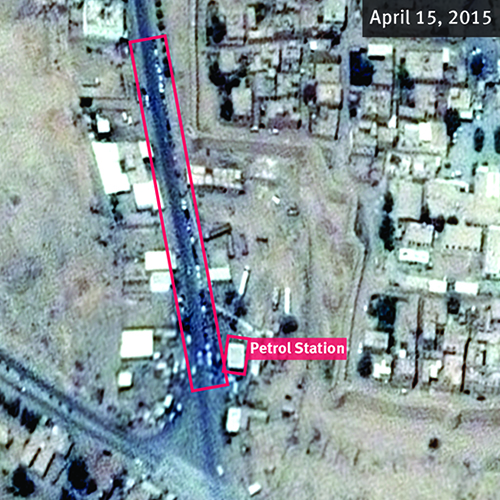 A line of small vehicles, approximately 175 meters long, queuing up by the Jarman petrol station on the morning of April 15, 2015, just hours before a coalition airstrike hit the station, causing a fire that killed at least five people and wounding at least 23. © CNES 2015/Distribution Airbus DS
A line of small vehicles, approximately 175 meters long, queuing up by the Jarman petrol station on the morning of April 15, 2015, just hours before a coalition airstrike hit the station, causing a fire that killed at least five people and wounding at least 23. © CNES 2015/Distribution Airbus DS
During its investigation of the site, Human Rights Watch found that the concrete overhang above the petrol pumps had collapsed, consistent with witnesses’ claims that a bomb struck the roof. There were seven burned-out vehicles in close proximity to the station. All of the vehicles appeared civilian. Five of the vehicles were small passenger mini-buses. Two cars were regular personal cars. Photos from the immediate aftermath of the attack that Human Rights Watch reviewed do not show any additional vehicles that would appear to be military.
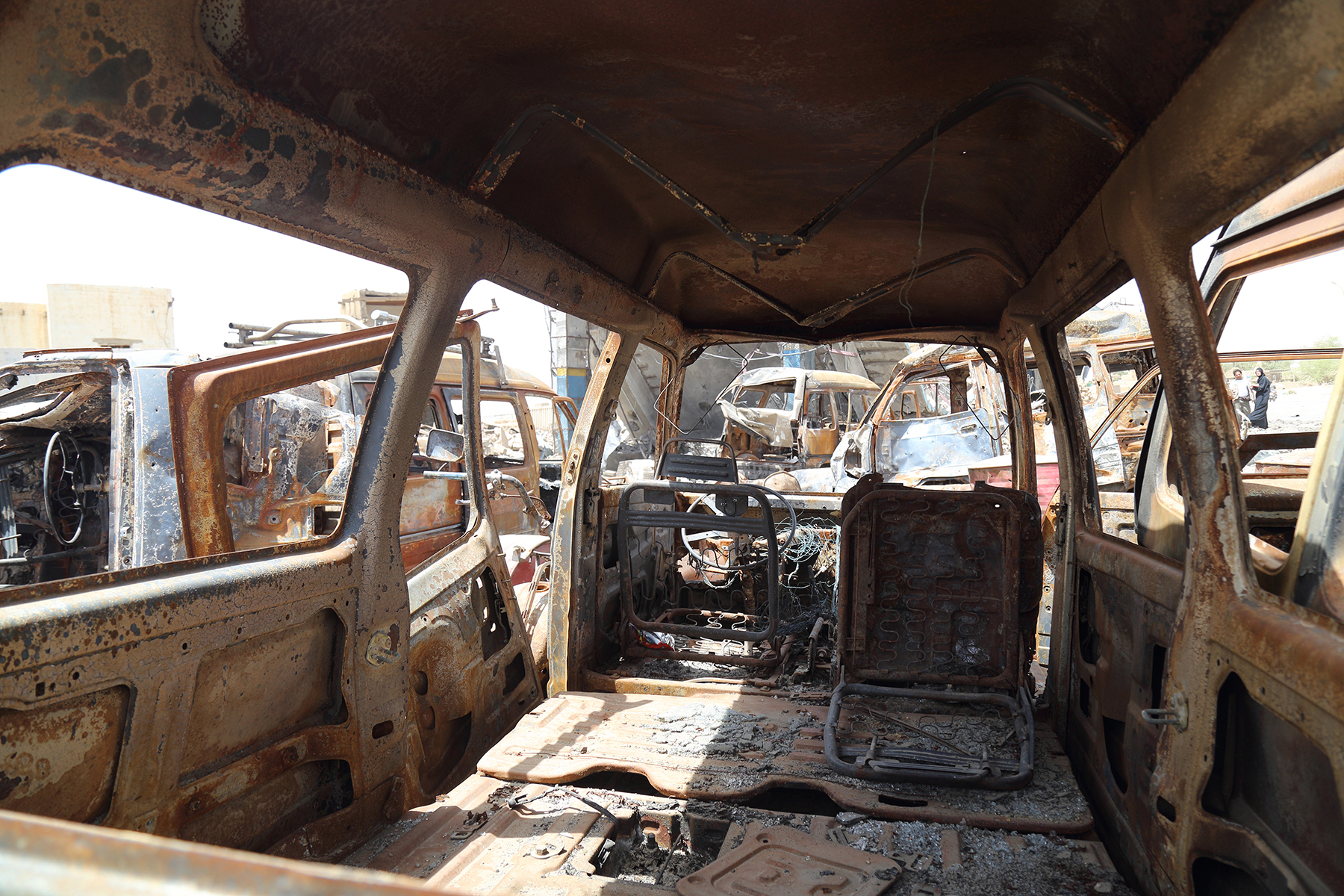 Burned-out cars lined up by the Jarman petrol station, which was struck in an aerial attack on April 15, 2015. © 2015 Ole Solvang/Human Rights Watch
Burned-out cars lined up by the Jarman petrol station, which was struck in an aerial attack on April 15, 2015. © 2015 Ole Solvang/Human Rights Watch
Because of the importance of fuel for military operations, depriving belligerent forces of fuel supplies is a legitimate military objective. Even so, for the coalition to attack a petrol station in the middle of the day when it could reasonably be determined that many civilians were present, instead of at night and after providing a specific warning, is contrary to the obligations to take all feasible precautions to minimize civilian harm and may amount to an unlawfully indiscriminate or disproportionate attack.